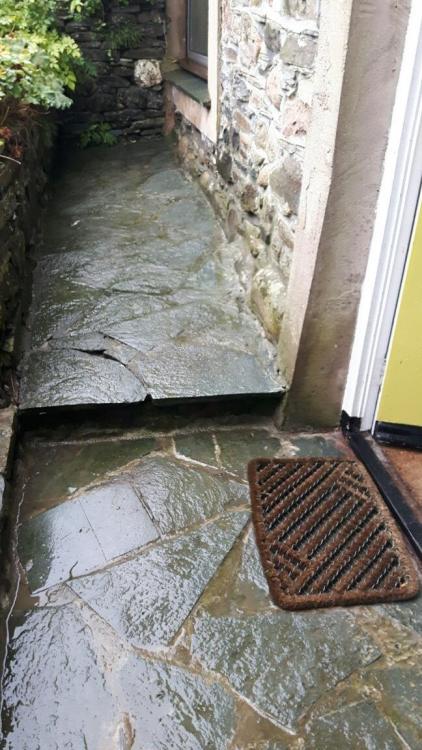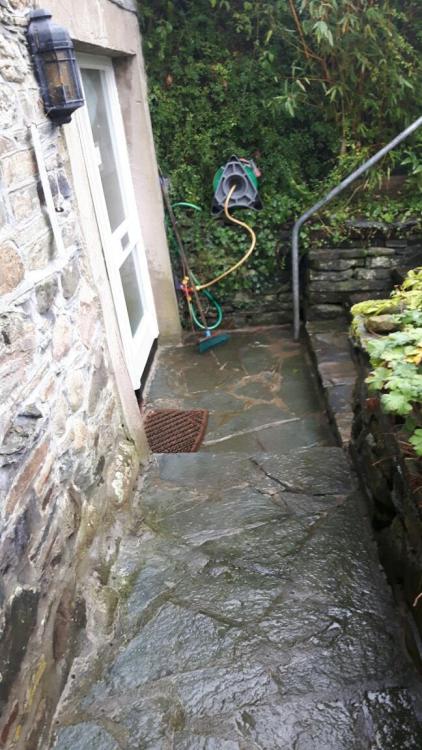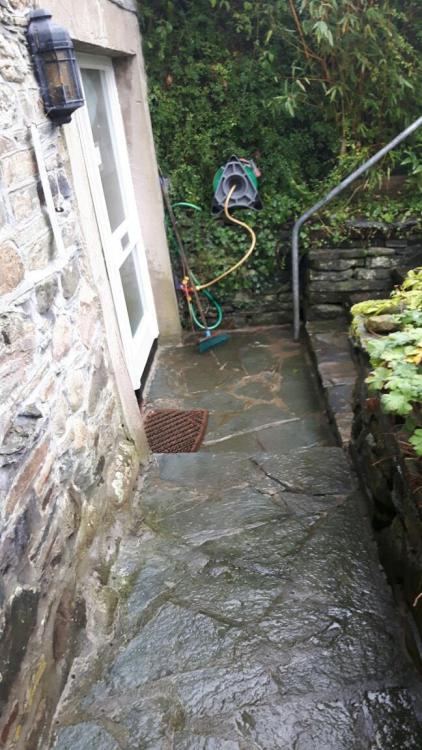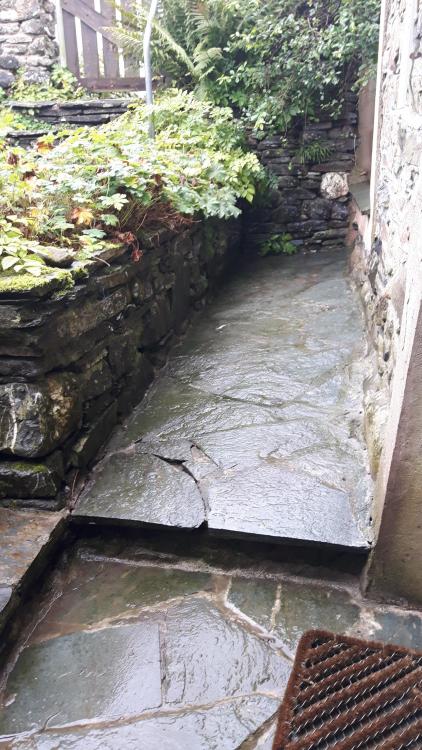
pilchard
Members-
Posts
10 -
Joined
-
Last visited
Recent Profile Visitors
The recent visitors block is disabled and is not being shown to other users.
pilchard's Achievements

Member (3/5)
1
Reputation
-
A couple of bits of wise advice re trial pit, and gauging the water-table depth. Whatever happens though, I had always intended installing a sump-pump outside and will still do that. I'll pass on digging inside the house at the moment though. It'd ruin the carpets. ? A trial pit outside is also something I had figured I would do anyway, but thought it a good idea to first get some thoughts from anyone with sufficient experience in matters pertaining to these kinds of situations... viz-a-viz footings of barns etc,. Whether or not any sane and experienced builder would ever consider that a seemingly half-arsed 4 to 5 inch deep by one metre wide slab of concrete against wall footings would realistically provide any support to the wall.... I still don't know.
-
- So it looks like the ground around your house is higher and when you have repointed using portland?............ YES - it will have created a waterproof trough stopping the water and forcing it to come up through the inside of the walls....... YES, that's my analysis. - So the old ground level will have been higher.... YES, but only on this side of the building. - So it looks to me like the builders have dug down around the barn so that they could get 2 floors inside or something like that.... NO, because there is no sign along the entire back elevation and almost completely level yard area of the the barn (now two houses) that foundation boulders have been either exposed or added, which would suggest that the interior floor level has been significantly dug out... and also, the interior concrete floor is the same level throughout. The old barn door porch-like structure... which I think in barn terminology is called a Forebay... and is located in the middle of the length of the rear elevation of the barn has its original squared and dressed quoins going all the way down to the ground with no evidence of footings showing or structural alterations. The current front wall... with front door... is the original back wall of the barn, and that obviously had soil up against it on a slope ranging from approx 1.5 metres to zero at the far end (next-door neighbours end) of the barn. Neither had the roof been raised as the original massive roof trusses are still in place. With ceiling heights of 2140 and 2260 for the two floors, looks like those 1970's builders just about squeezed into minimum heights. A longish negative answer to that last one. All my powers of reasoning , problem solving, and analysis have had me concluding that it is very unlikely that the foundations on the (now referred to) front wall of our cottage have been altered or upgraded. This now brings me back to my original worry. Is that pad of lime waterproofed bedding below the crazy paving providing any structural stability to the already partially exposed bouldery 19th century agricultural footings? Can I blithely dig it out???????? in order to do a french drain burrito job, topped off with gravel and loose-laid stepping-stone slabs, with everything draining into a sump-pump?
-
You seem to be mirroring my own tentative conclusions Lorenz. There is generally a pretty good slope on this crazy-paving, draining rain-water away from the house wall, and although there is no installed gully or culvert to take it away there is an historic natural drainage point that runs the surface water under the garden wall to next door. It's not great, I've long intended to improve it with a sump-pump, but it currently just about does the job... and I keep it unblocked. I had thought it was rainwater soaking in through poorly maintained pointing around the paving, until I fixed that and made the surface impervious. That's when I got the internal flooding. My explorations... doing test drillings... indicate there is a 10 to 12cm of dry impervious high lime content base below the paving which, although good at preventing water going down, is probably doing a better good job of stopping water coming up through the paving. That water now has to come up somewhere.... through the footings of the 2ft thick 150+ years old random stone barn wall. Those are my conclusions anyway. My current fear is what to do about that slab of 10 to 12cm thick impervious concrete. I was going to lay a french drain to feed a sump-pump. Slotted corrugated pipe in gravel wrapped in non-woven geo-fabric like a burrito, more gravel topped with some loose and spaced out concrete slabs. I wasn't expecting to have to dig out a slab that might be helping to stabilise the footings? The photos (which I'll probably have to send in separate replies due to upload limits) may help explain to some degree how this area is effectively a hole in the ground up against the wall and front door of the house, with the land falling approx 1.5 metres (at the garden gate) to nothing (at hose-pipe) along the length of that front elevation. The visible water is due to me having sprayed and brushed the area clean. The coconut matt just visible inside the door is a small entrance area stepped approx 10cm lower than the rest of the interior floor.
-
There WILL be foundations... of sorts... but as the cottage is converted from an old 19th century (or earlier) stone built barn with 2ft thick walls., they'll not be anything more technical than large boulders packed into a trench. How deep or wide.... I wouldn't like to guess, but as the entire barn is still stood good and straight with no sagging or bellying, I'd guess they were, and still are, up to the job. Please explain why "Lime mortar springs to mind". There is no evidence of the kind of structural probs you are suggesting, and... not a brick in site. All mixed west Lakeland stone.
-
Big job Tony. Respect. Lets hope my little cottage don't need that kind of effort... my largest core-drill is only 5 inch.
-
I'll have to look up the Grand Designs Bothy episode... I do enjoy a good wince. It's sounding like you are probably confirming my own diagnosis of Ground Water Pressure... AKA Hydrostatic Pressure... so I'm assuming I'm on the right track. I also had been thinking small sump pump... collecting from a french drain. I think it does need both because, depending on soil structure, the sump pump might only collect water draining from a limited area whereas the french drain and sump pump combo will serve the entire wall. But... having explored below the crazy paving and found between 10 &12cm of concrete... as observed by several test drillings... I am not totally sure at this point of the wisdom of removing it. That thickness seems well OTT for bedding crazy paving, but also a little insubstantial to have been laid to assist the footings in any way. Also... the test-drilling came up white, suggesting lime in the mix... possibly hydrated lime used as a waterproofer. If as a waterproofer, it certainly has worked because all the dust coming up was as dry as a bone. This kind of work is really not my bag and having had no experience of ground-works or foundations etc... i'm well out of my depth and quite nervous about potentially mucking about with foundations. A French drain and sump pump are theoretically straightforward, until you start digging.
-
By the look of it, the ground level has already been excavated as low as the builders who converted the place dared to go. There are one or two pretty hefty boulders projecting out from the base of the wall, so my assumption is that they are the footings. I had thought of photos, but it can be difficult to paint the whole picture with them, and I hoped my explanation might be sufficiently detailed. Maybe I'll wait 'til there are one or two more responses.
-
We have what seems to be a ground water pressure problem, with water seeping in at the base of the solid stone front wall of our house. The house is part of what once was a Lakeland barn, converted in the 1970's. Other than the gable end of the house obviously and successfully having been tanked with membrane and a block wall, there is no evidence of any damp-proofing other than the redundant remains of an electro-osmotic system. Although the crazy-paved outside ground level immediately in front of the north facing house is more or less level with the interior concrete floor, it is only about a metre wide and then there is an almost a metre high stone wall retaining the flower beds etc that make up the rest of the garden area. The building is effectively tucked into a generally sloping landscape. We've always had some historic and fairly minor damp issues which I'd suspected was surface water ingress soaking through the base of the wall, so early in the year I raked out the old and loose pointing to that strip of old crazy-paving at the front and renewed by dry-pointing. Then we had continuous heavy rain for a number of weeks and water began pooling inside by the front door and wetting carpets along that front wall. That made me reconsider and suspect I may have misdiagnosed the problem and by sealing up all the cracks and loose bits I had actually made things worse. It wasn't surface water sinking into those cracks but ground water coming out from below under pressure and finding any convenient escape route. By sealing the cracks outside, I may have forced the water pressure previously seeping mainly outside and a little inside, to build up and seep inside the house rather than harmlessly outside; turning minor damp into limited localised flooding. During those wet weeks, suspecting the issue being ground-water pressure, I drilled a small hole in the repaired pointing just outside the front door and was surprised to see I had created a tiny spring, with water welling out of it 1 to 2 cm high that continued to run for an hour or two. That encouraged me to drill more random holes close to the wall footings. This may have helped, because no more water came in and carpets and door-mats etc. gradually dried, although.... it had also stopped raining and we've had a pretty dry year so far. So, whether this has helped is hard to say until we get some more prolonged wet weather, but I've never viewed it as a permanent solution. I've been looking into installing a French Drain and other "dewatering" solutions but, having explored by removing one of the larger bits of crazy paving, then also doing some test drillings it seems it is all laid on what might possibly be an OTT slab of concrete for crazy-paving... possibly 10 or 12 cm thick..., or might also possibly be the 1970's builders attempt at providing additional bolstering support to the ancient and very bouldery agricultural footings. A bit of a quandary that needs some experienced insights and advice. Anyone?
-
Hi all. I must admit to having joined in the hope of gaining advice on a particular current problem well beyond my experience and skills... but I suppose that's why most are here, and decided to stay. I've always wanted to build a Modernist SIPs house.... all flat-roof, glass wood and steel, but never managed to acquire the bank-balance needed. So instead I have to content myself with renovations to my little Lakeland cottage.





